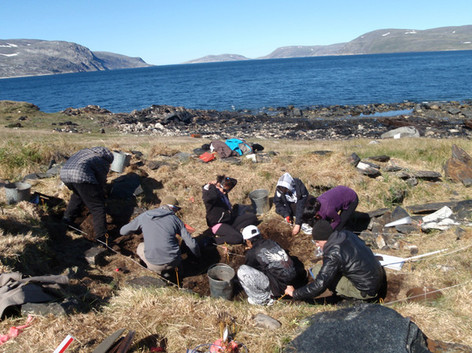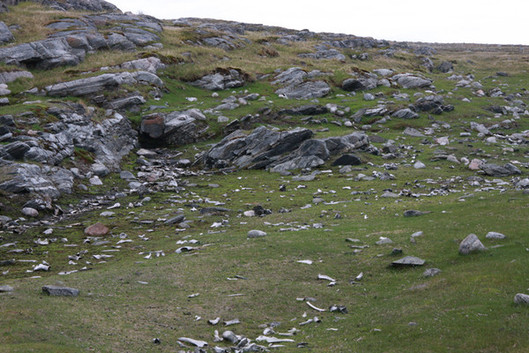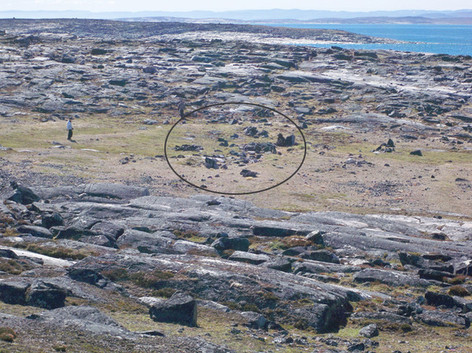2010 Fieldwork – Kangiqsujuaq Region
By Daniel Gendron and Hervé Monchot
Kangiqsujuaq, located on the south shore of Hudson Strait (Ungava Peninsula, Nunavik), has attracted archaeologists for more than 40 years and resulted in the identification of numerous sites of various origins (e.g. Pre-Dorset, Dorset Thule/Inuit) and covering almost 4000 years of occupation, including several soapstone quarries dating back to the beginning of the Dorset occupation some 2000 years ago. Two of these also exhibit petroglyphs (engravings representing anthropomorphic faces in the soapstone). The first, is at a place named Qajartalik (JhEv-1), and the second is at Upirngivik (JgEu-1). Throughout the years, these project resulted in the identification of over 100 archaeological sites of all ages. These rich and varied occupations may be explained by the privileged geographical location of the area, where a constant flow of migratory species, including many sea mammals (walruses, different species of seals, whales), fishes and birds keep the waters and surrounding islands and the mainland striving with life. This area is also comprised by a polynia (e.g., portion of the water is ice-free year round), which makes it an ideal location for living.
In July 2010, following a request by the Kangiqsujuaq Landholding Corporation, Nunaturlik, the Avataq Cultural Institute, through its CURA-ASI research programme, carried out an initial research stage within the ‘cultural tourism’ framework. This past Summer, the work concentrated on the excavation of an Thule/Inuit house at Qarmait, near the Village and a visit to Aivirtuurq approximately 40 km to the southeast of Kangiqsujuaq.
QARMAIT
The JjFa-1 site is located 2 km to the Southwest of the Village, at a place called Qarmait. The site is composed of several historical structures, but its main features are the 6 semi-subterrenean houses dating back to early Thule/Inuit occupations. A Dorset presence is also confirmed underneath the Inuit occupations. The dwellings are typical Late Fall/Early Winter houses (qarmait) accessible through a more or less long entrance way comprised of the ‘cold trap’ and, sometimes, a cache; the interior of the houses are difficult to see because of all the rocks that collapsed in the interior, but the excavation of Structure 6 indicated that they are typical of the time period with at least one cooking area, and a sleeping platform at the back. The outer rim that delimits the interior of the house is more than one metre deep. This site has been sampled and presented in the litterature on some occasions (Barré 1970, Avataq Cultural Institute, 1988), and many rumours of pillaging circulates in the village, but with the exception of very limited traces of the latter the habitations appear to be fairly intact and suited for a locally sponsored archaeological project that involved the participation of several Inuit youth. Structure 5 yielded an interesting variety of artefacts that both relate to their Thule/Inuit and Dorset occupations. Several harpoon tips, knives and end blades, as well as numerous organic remains (e.g. bone and ivory) representing several species (caribous, seal, walrus, beluga, etc.) have been collected in situ (e.g. in undisturbed archaeological context). The results of this first campaign are warranting a return for 2011 to continue the excavation project. Its proximity to the Community make of this site an ideal location to develop an archaeological field school and a potential touristic attraction. One of the future project linked to the excavation will be to reconstruct one of the houses to show visitors how people lived in Nunavik some 600 years ago.
AIVIRTUUQ
The Aivirtuuq Peninsula, which separates Joy Bay and Whitley Bay on the southern Hudson Strait, is a central place in the landscape in the physical sense, but it is also central in the lives of the Inuit. The name implies an intense relationship with the walrus and is reflected in the abundance of walrus remains in almost every corner of the Peninsula, which was visited on several occasions by archaeologists who identified 17 archaeological sites representing human occupations from the earliest times. However, there was never any archaeological work of significance that was carried out at this location. Last Summer, Avataq spent several days at Aivirtuuq to establish the potential for a long-term archaeological project. The work focused on 2 potentially very important archaeological sites:
Saunirtalik or the “River of Bones” (JiEv-15)
The JiEv-15 site was first identified in 2001 during a survey under the CURA project ‘From Tuniit to Inuit’, and right then it was of particular interest because of its unusual nature; it is essentially a midden with thousands of bones lying at the foot of a steep escarpment. The location was visited some years later by Kangirsujuammiut and its interest for the community was brought to Avataq’s attention. Following an agreement with Nunaturlik, we undertook a preliminary survey of the site to evaluate the research and touristic potential of JiEv-15. The result of this work clearly established the importance of the location. In addition, we identified two more ‘river of bones’ clearly linked to the first one. We also found evidence that the place was home for humans some 3000 years ago. All in all, the site now covers one square kilometer, and is certainly in continuity with other important historical locations at Aivirtuuq.
Saunirtalik is located at approximately 35m in altitude and several hundred meters from both shorelines (to the north and the south), and because the bones identified are mostly from large sea mammals (e.g., walrus and bowhead whales), this location is intriguing. This suggests that the place was used during the Winter months when carrying large prey to a camp site would have been easier. Also, numerous artefacts were identified, including Inuit implements made out of bones, ivory, wood, and soapstone, and trade goods (e.g. metal knives, cups, cartridges, etc.). The most intriguing object is a pistol barrel that could date back to the mid 1800s. The location itself is not remembered as an important campground by the Elders, although some stories about this area are still part of the collective memory. This fit with the relative age of the trade goods found at Saunirtalik, which we presume to be from the middle of the 19th century, well over 150 years ago.
A Dorset Long House (JiEv-4)
The first long house that was discovered in Nunavik, near Kangirsuk, was thought to be of Norse origin according to its excavator, Thomas Lee, who went on to reconstruct the dwelling accordingly. However, Further excavation of another long house near Quaqtaq proved that they were in fact of Dorset origin. In the late 1970s, Patrick Plumet went on to identify a few more of these huge dwellings, one of them at Aivirtuuq (JiEv-4). During several visits in the late 1990s and the early 21st century, we were unable to re-locate the latter. This past Summer, we decided that we would try an ultimate attempt at finding this house again, and quite by chance we did ! Walking from the ‘River of Bones’ we intended to reach the eastern extremity of Aivirtuuq where the long house was supposedly located. After a few hundred meters, one of us looked down from the upper grounds and there it was in a small bay less than 500 meters from where we were camping, but over 1.5 km west from where Plumet had located it !
The house measures 24m in length and is marked by a slight to moderate depression. Each extremity is identified by a large upright rock. Interpretations of this type of dwellings may vary, but they were most likely used as a habitation for several family meeting together, possibly after the long Winter months. These dwellings are rare, so we were fortunate to re-locate this one. It will certainly be part of the long-term research project at Aivirtuuq.
Have participated to the 2010 Project:
Benjamin Patenaude, Brendan Fenerty, Mary Uqittuq, Lizzie Pinguatuq, Sheila Alaku, Adamie Jaaka Jr, Danielli Jaaka.



